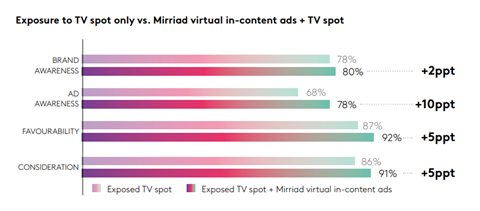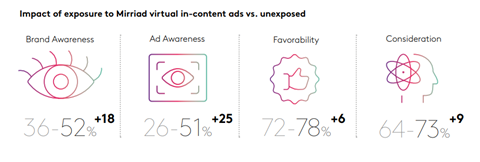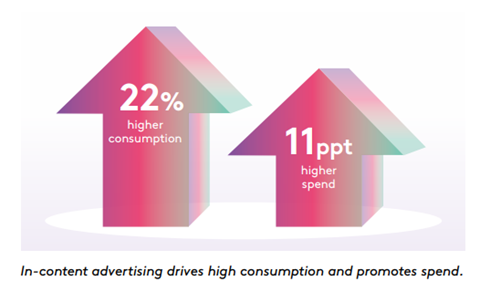With brands facing enormous pressure, and the industry demanding new solutions, we have seen a profound evolution of opportunities in advertising strategy. Driven by advances in technology, virtual in-content advertising and product placements offer brands a path to scalability and frequency control.
Virtual in-content advertising comprises product placements, signage, video, and other creative formats added into TV and video content. This approach leads to improved campaign effectiveness, particularly when it comes to brand awareness marketing. The rolling framework of research studies has proved the success of in-content advertising campaigns and has given advertisers the confidence they sought for increased investment in this new and exciting advertising opportunity.
To delve further into content advertising solutions, Kantar worked alongside advertising agency Mirriad to survey consumers in three groups, each exposed to different ad types:
- Group one: unexposed to TV or in-content ads like product placement
- Group two: only saw TV spot activity
- Group three: saw multiple ad formats – both a TV spot and in-content advertising

The impact of in-content ads on advertising metrics and ROI
Our research shows that in-content advertising has incredibly high results across ad awareness, brand awareness, favorability, and consideration when compared to Kantar norms. The results offer proof in driving sales and amplifying TV spot campaigns, as well as a high likability with consumers. A large majority of viewers favor in-content ad formats which also drives brand salience and appeal.
With media costs soaring, advertisers need to ensure their campaigns are working harder than ever to drive ROI. In-content advertising, when combined with TV spots, can increase sales by up to 20 percentage points.
As advertisers face global audience declines, especially on offline broadcast media such as TV, it is an emergent finding that in-content advertising can help to alleviate the impact of this. They do this by generating incremental reach, due to viewers being more engaged, and because advertisers aren’t competing for share of voice against other spots within an ad break. Furthermore, reaching relevant target audiences for advertisers is crucial and in-content ads prove successful in targeting engaged audiences, leading to better Brand Recall.

Our study found that those who saw both ad formats, rather than solely a TV spot, reported higher brand awareness, ad awareness, favorability, and consideration with increases of 2%, 10%, and 5% respectively from a high baseline. 56% bought products featured in the ads after exposure, compared with 34% following TV spot exposure only.

Positive consumer reaction to in-content ads
In-content advertising provided an audience gain of 22% to 49% when compared to TV spot breaks, but this varies by program and market. In-content ads also performed well against other global media channels when factored into Kantar’s annual reports around consumer perception of media channels.
Attitudes to in-content advertising were found to be “largely positive” compared to traditional media channels, with 79% of consumers surveyed saying they like the format, 77% saying they were innovative, and more than three quarters (76%) reporting in-content ad formats make the brand more appealing.
What makes a successful in-content ad campaign?
Advertisers need to choose the right method of in-content advertising for their product: product placement works well for immediately distinguishable brands, while signs such as billboards are more effective for less recognizable brands.
A key question an advertising strategy will seek to understand is how different creative formats perform, such as products versus signage. Across all campaign studies, results showed that both formats work almost equally as effectively.
The average awareness of product integrations was 62%. For signage integrations, this was 65%. These averages show small variation between individual placement, proving that other factors play a much more pivotal role in the overall success of driving awareness.
Signage and product brand integrations complement each other in advertising campaigns. There are opportunities within both for separate uses. For example, product integrations drive implied usage and signage can be used to deliver brand messaging.
These findings reveal that in-content ad formats have the potential to work even better when you have two complementary brands, meaning the inventory can be shared. This gives advertisers the ability to increase brand awareness and Favorability, while avoiding Ad Fatigue. In fact, the combination of ad types increases Brand Appeal overall. However, it is even more important to maximize the contextual relevance and ensure ad placement is not distracting, to avoid a negative consumer reaction from integrations that are positioned in a jarring way.
Creating strategies that include multiple ad formats that work together, such as in-content ads with TV spots, will be the key to success in today’s always-on world. Find out more about the effectiveness of in-content advertising by downloading the whitepaper from Kantar and Mirriad,
